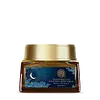What's inside
What's inside
 Key Ingredients
Key Ingredients

 Benefits
Benefits

 Concerns
Concerns

 Ingredients Side-by-side
Ingredients Side-by-side

Water
Skin ConditioningStearic Acid
CleansingCetyl Alcohol
EmollientCetearyl Olivate
Sorbitan Olivate
EmulsifyingCyclopentasiloxane
EmollientDimethicone
EmollientDimethicone Crosspolymer
Emulsion StabilisingPhenyl Trimethicone
Skin ConditioningPanthenol
Skin ConditioningXanthan Gum
EmulsifyingEDTA
Velvet Extract
HumectantAralia Racemosa Extract
Skin ConditioningShorea Robusta Leaf Extract
AstringentSesamum Indicum Seed Oil
EmollientCrocus Sativus Flower Extract
MaskingPhenoxyethanol
PreservativeMyristica Fragrans Extract
MaskingAlysicarpus Vaginalis Extract
Skin ConditioningMesua Ferrea Flower Extract
Skin ConditioningCananga Odorata Flower Powder
Skin ConditioningArctium Lappa Root Powder
Skin ConditioningCocos Nucifera Fruit Extract
EmollientCinnamomum Zeylanicum Bark Extract
AntimicrobialCedrus Deodara Wood Extract
Skin ConditioningElettaria Cardamomum Seed Powder
Skin ConditioningCaprae Lac
Skin ConditioningCallicarpa Macrophylla Flower Extract
Caesalpinia Sappan Stem Powder
ExfoliatingAloe Barbadensis Leaf Juice
Skin ConditioningAllantoin
Skin ConditioningWater, Stearic Acid, Cetyl Alcohol, Cetearyl Olivate, Sorbitan Olivate, Cyclopentasiloxane, Dimethicone, Dimethicone Crosspolymer, Phenyl Trimethicone, Panthenol, Xanthan Gum, EDTA, Velvet Extract, Aralia Racemosa Extract, Shorea Robusta Leaf Extract, Sesamum Indicum Seed Oil, Crocus Sativus Flower Extract, Phenoxyethanol, Myristica Fragrans Extract, Alysicarpus Vaginalis Extract, Mesua Ferrea Flower Extract, Cananga Odorata Flower Powder, Arctium Lappa Root Powder, Cocos Nucifera Fruit Extract, Cinnamomum Zeylanicum Bark Extract, Cedrus Deodara Wood Extract, Elettaria Cardamomum Seed Powder, Caprae Lac, Callicarpa Macrophylla Flower Extract, Caesalpinia Sappan Stem Powder, Aloe Barbadensis Leaf Juice, Allantoin
Water
Skin ConditioningSorbitan Olivate
EmulsifyingMoringa Oleifera Seed Oil
EmollientCaprylic/Capric Triglyceride
MaskingSesamum Indicum Seed Oil
EmollientTriticum Vulgare Germ Extract
Skin ConditioningPrunus Amygdalus Dulcis Oil
Skin ConditioningCeramide AP
Skin ConditioningSaccharide Isomerate
HumectantPolyglutamic Acid
Skin ConditioningBakuchiol
AntimicrobialHydrolyzed Manihot Esculenta Tuber Extract
Skin ConditioningBetaine
HumectantSqualane
EmollientPropanediol
SolventXanthan Gum
EmulsifyingHydrolyzed Sodium Hyaluronate
Skin ConditioningBacillus/Folic Acid Ferment Filtrate Extract
AntioxidantGlycerin
HumectantTocopheryl Acetate
AntioxidantSantalum Album Extract
CleansingMilk
Skin ConditioningCrocus Sativus Flower Extract
MaskingCaprylyl Glycol
EmollientPhenoxyethanol
PreservativeGlycyrrhiza Glabra Root Extract
BleachingHexylene Glycol
EmulsifyingGold
Cosmetic ColorantCurcuma Longa Root Extract
MaskingWithania Somnifera Root Extract
Skin ConditioningJasminum Sambac Flower Oil
MaskingWater, Sorbitan Olivate, Moringa Oleifera Seed Oil, Caprylic/Capric Triglyceride, Sesamum Indicum Seed Oil, Triticum Vulgare Germ Extract, Prunus Amygdalus Dulcis Oil, Ceramide AP, Saccharide Isomerate, Polyglutamic Acid, Bakuchiol, Hydrolyzed Manihot Esculenta Tuber Extract, Betaine, Squalane, Propanediol, Xanthan Gum, Hydrolyzed Sodium Hyaluronate, Bacillus/Folic Acid Ferment Filtrate Extract, Glycerin, Tocopheryl Acetate, Santalum Album Extract, Milk, Crocus Sativus Flower Extract, Caprylyl Glycol, Phenoxyethanol, Glycyrrhiza Glabra Root Extract, Hexylene Glycol, Gold, Curcuma Longa Root Extract, Withania Somnifera Root Extract, Jasminum Sambac Flower Oil
Ingredients Explained
These ingredients are found in both products.
Ingredients higher up in an ingredient list are typically present in a larger amount.
We don't have a description for Crocus Sativus Flower Extract yet.
Phenoxyethanol is a preservative that has germicide, antimicrobial, and aromatic properties. Studies show that phenoxyethanol can prevent microbial growth. By itself, it has a scent that is similar to that of a rose.
It's often used in formulations along with Caprylyl Glycol to preserve the shelf life of products.
Sesame oil comes from sesame seeds. Sesame oil is rich in fatty acids and Vitamin E.
It has antibacterial, antioxidant, and anti-inflammatory properties. The phenolic compounds of this ingredient (including vitamin E) give it these properties.
Unrefined sesame oil has a comedogenic rating of 3, while refined sesame oil has a rating of 1. This ingredient may not be fungal-acne safe.
The fatty acids in sesame oil include linoleic acid (41%), oleic acid (39%), palmitic acid (8%), stearic acid (5%), and some small traces of others.
Learn more about Sesamum Indicum Seed OilSorbitan Olivate is created from the fatty acids in olive oil and sorbitol.
This ingredient is an oil in water emulsifier. It helps stabilize a product by preventing oils and waters from separating. Sorbitan Olivate also helps hydrate the skin.
Manufacturers sell sorbitan olivate under the name OliveM 1000. OliveM 1000 a multifunctional ingredient. It is self-emulsifying. According to a manufacturer, OliveM 1000 does not disrupt natural skin biome.
Due to its olive oil base, this ingredient may not be fungal-acne safe.
Learn more about Sorbitan OlivateWater. It's the most common cosmetic ingredient of all. You'll usually see it at the top of ingredient lists, meaning that it makes up the largest part of the product.
So why is it so popular? Water most often acts as a solvent - this means that it helps dissolve other ingredients into the formulation.
You'll also recognize water as that liquid we all need to stay alive. If you see this, drink a glass of water. Stay hydrated!
Learn more about WaterXanthan gum is used as a stabilizer and thickener within cosmetic products. It helps give products a sticky, thick feeling - preventing them from being too runny.
On the technical side of things, xanthan gum is a polysaccharide - a combination consisting of multiple sugar molecules bonded together.
Xanthan gum is a pretty common and great ingredient. It is a natural, non-toxic, non-irritating ingredient that is also commonly used in food products.
Learn more about Xanthan Gum